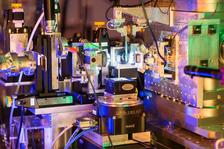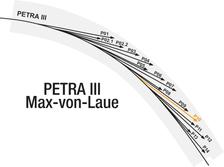The location of P10 in the Max-von-Laue Experimental Hall is marked in orange.
The Coherence Beamline P10 benefits from the outstanding brilliance of the PETRA III storage ring. The flux of coherent synchrotron radiation exceeds that delivered by existing storage ring based sources. P10 is situated in sector 7 of PETRA III and a 5m long U32 undulator is installed in the straight section in low beta configuration. The old U29 undulator has been replaced at the beginning of 2020. The beamline operates in the medium-hard X-ray regime (5-20keV).
The beamline serves two main experimental goals:
- Investigation of sample dynamics in the range from microseconds to seconds by X-ray Photon Correlation Spectroscopy (XPCS).
- Coherent diffractive imaging of micro- and nanostructures (CDI, BraggCDI, Holographic imaging).
Currently, the optics hutch contains a standard PETRA III high heat load monochromator and a pair of horizontally reflecting, flat (R > 100km) mirrors. In addition, it is foreseen to get pink beam capability at the beamline (the high heat load mirror is still missing).
The first experimental hutch EH1 houses three experimental setups:
i) It contains a specialized setup to study dynamics of soft matter systems with a sample-to-detector distance of ~21.3m and relatively large beam sizes. The accessible Q-range is limited (Q < 2*10-2Å-1 @ 8keV), but the reduced flux density is be beneficial for many soft matter systems.
ii) A large 6-circle diffractometer has been installed at the beginning of 2013. This diffractometer will serve the growing need to reach large scattering vectors Q for coherent scattering experiments.
iii) A vertical SAXS setup in combination with a HAAKE Mars Rheometer has been installed at the end of 2011. Time-resolved studies of complex liquids are performed here. This setup is no longer available for external users as of 2019.
The second experimental hutch EH2 is home to the standard sample environment of the beamline and to the GINIX setup designed by the group of Prof. T. Salditt of the University of Göttingen. The standard setup is based on a Huber 4-circle diffractometer and operates usually with a sample-to-detector distance of ~5 m using an evacuated flight path before the detector stage. Two micro-focusing option using compound refractive lenses (~1x1µm^2 ,~ 3x3µm^2 ) are available. The GINIX setup uses KB focusing optics (focal size ~300x300nm^2 ) in combination with waveguides to produce very small (down to 10x10nm^2 ) divergent beams for holographic imaging experiments.
Furthermore, the beamline has several supporting laboratories. Details to all these options can be found in the "Infrastructure" section.
Please keep the following points in mind if you consider to perform an experiment at P10:
- Discuss feasibility of your experiment with the beamline staff in advance
- Hardware components not listed on the beamline web pages are normally not available at the beamline. Their availability has to be organized well in advance.







